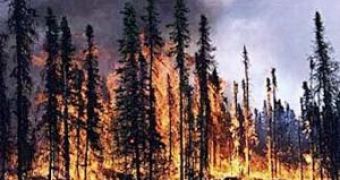A team of specialists from NASA have found that global temperatures have been increasing with 0.6 ?C during the past 30 years. "Further global warming of 1 ?C defines a critical threshold. Beyond that we will likely see changes that make Earth a different planet than the one we know." says Jim Hansen, director of NASA's Goddard Institute for Space Studies in New York.
Earth has already reached its peak average temperature in the last 10,000 years and 1 ?C more would be the peak for a million years. Warming is being felt especially in the high latitudes of the Northern Hemisphere. Permanent Arctic sea ice has contracted by 14 per cent in the past two years.
But most studies have focused on the melting ice cap and had somehow neglected the effect on the northern coniferous forest (the taiga) of Siberia and North America. Another decade of carbon emissions at the current rate will probably trigger great climate changes. Warming and melting have been just as dramatic on land in the far north as on the ice cap.
Geographer Heiko Balzter, of the University of Leicester, said "Central Siberia has warmed by almost 2 ?C since 1970 - that's three times the global average."
"Warming has caused the onset of spring to advance by as much as one day a year since satellite observations began in 1982," says Balzter.
Stuart Chapin of the University of Alaska Fairbanks reported an air temperature increase in the Alaskan interior of 2 ?C since 1950, and permafrost temperature of 2.5 ?C. "Alaskan springs now arrive two weeks earlier than in 1950," said Chapin.
Rising temperatures are triggering ecological changes. Vladimir Petko from the Russian Academy of Sciences Forest Research Institute in Krasnoyarsk reported that warmer springs favor moth invasions. "They can eat the needles of entire forest regions in one summer," he says.
"The trees die and then usually succumb to forest fires that in turn destroy soil vegetation and accelerate the melting of permafrost," Petko says.
In 2003, forest fires devastated 40,000 square km in Siberia. In Alaska, warming has shortened the life cycle of the bark beetle from two years to one, causing huge invasions and subsequent fires, which provoked huge forest fires in 2004. "The current boreal forest zone could be so dried out by 2090 that the trees will die off and be replaced by steppe," says Nadezhda Tchebakova, also at the institute in Krasnoyarsk.
Melting permafrost in the taiga and tundra (Arctic steppe) is triggering the release of methane, a powerful greenhouse gas, from the previous frozen thick layers of peat. "Large amounts of greenhouse gases are currently locked in the permafrost and if released could accelerate the greenhouse effect," says Balzter.
"In past eras, the release of methane from melting permafrost and destabilized sediments on continental shelves has probably been responsible for some of the largest warmings in the Earth's history," he says.
"We could be close to unleashing similar events in the 21st century," Hansen argues.
"Although the feedbacks should remain modest as long as global temperatures remain within the range of recent interglacial periods of the past million years, outside that range - beyond a further warming of about 1 ?C - the feedbacks could accelerate. Such changes may become inevitable if the world does not begin to curb greenhouse gas emissions within the next decade," Hansen says.
A study of the taiga forests by environmental consultant Mark Anielski of Edmonton, Canada, puts the value of their "ecosystem services" at $250 billion a year, or $160 per hectare. "The value of the services this ecosystem performs is more than twice that of the resources taken from the region each year."
The taiga is important because it controls floods, purifies water, control pests through its bird population. Moreover, tourism and bush meat (like caribou) add to these income sources. "The value of these ecosystem services is more than twice that of conventional resources taken from the region each year, such as timber, minerals, oil and hydroelectricity," Anielski says.
"If they were counted in Canadian inventories of assets, they would amount to roughly 9 per cent of our gross domestic product - similar in value to our health and social services." And the taiga locks away a huge volume of carbon. "The boreal region is like a giant carbon bank account," he says. "At current prices in the European carbon emissions trading system, Canada's stored carbon alone would be worth $3.7 trillion."

 14 DAY TRIAL //
14 DAY TRIAL //